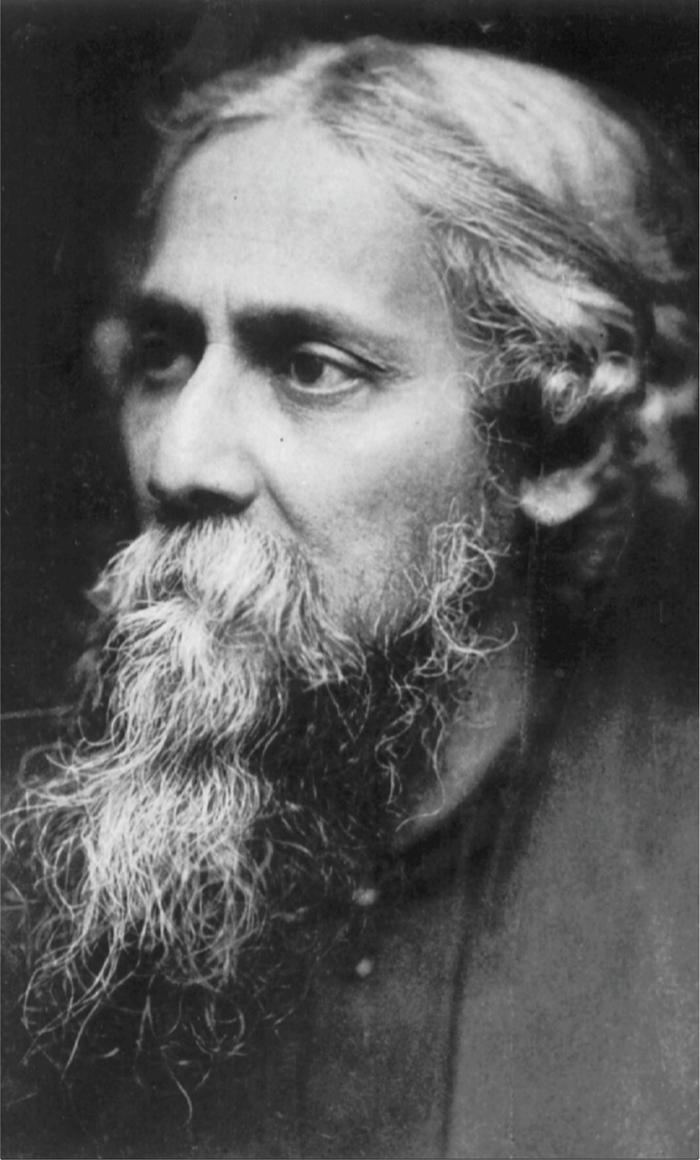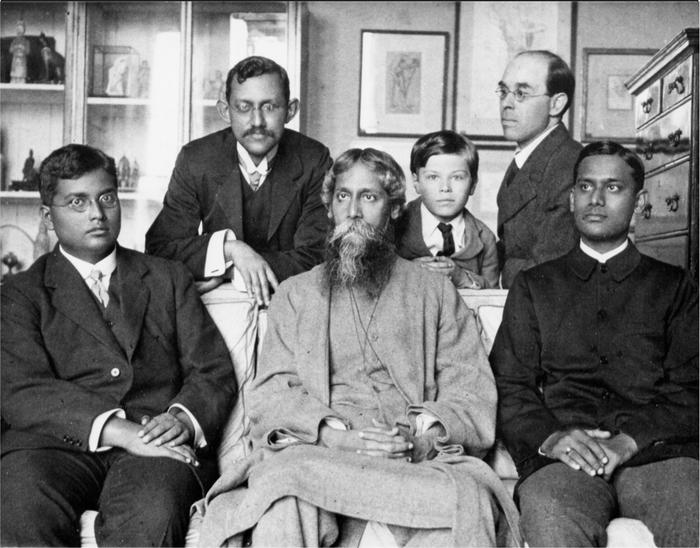I Won't Let You Go (6 page)
Read I Won't Let You Go Online
Authors: Rabindranath Tagore Ketaki Kushari Dyson

Tagore was a great champion of the individual. In his fictional work he often portrays the thinking, conscientious, lonely
individual
, alienated from the unthinking and dogmatical group and liable to be persecuted by it. The vulnerable individual is often the focus of his attention in poetry too, as in the poem ‘The Boy’ in this anthology. He was acutely aware of the oppression of women and looked forward to the coming of an epoch when men and women would be equal partners.
Tagore’s thinking mind and the times in which he lived inevitably involved him in political gestures. At home, he wrote songs which protested against Curzon’s partition of Bengal; returned his knighthood after the Amritsar massacre; spoke out against terrorism as a political strategy, to the displeasure of those who favoured it; criticised aspects of Gandhi’s non-cooperation movement and engaged in dialogues and debates with him. These activities made him an all-India figure and won him the
admiration
of both Gandhi and Nehru. Abroad, he exposed the horrific dangers of competitive, aggressive nationalism in a series of
lectures
(
Nationalism,
1917), to the annoyance of Britain, the USA, and Japan. He was fully aware of the pressing need to oppose
fascism
(see poem no. 18 of
Prantik
in this book) and died profoundly saddened by the way in which the world was hurtling towards another major war, but he never lost his faith in humanity. Some of his poems are known to have inspired conscientious objectors to war in Britain during the Second World War.
5
Tagore died before the full horrors of Nazism became common knowledge and before the partition of his native land.
The high quality of Tagore’s achievements in a diversity of fields assures his pre-eminent position within the Bengali cultural tradition. In that context he is still very much alive, a focal point of lively debates and controversies. Fortunately for the Bengali
literary
scene, a generation of writers who regarded themselves as post-Tagoreans established themselves before Tagore’s death, in the 1930s, so that there was no literary vacuum after his death. On the contrary, there were enough writers to take Bengali
writing
successfully forward from the point where he left it, and the two decades after his death were remarkably fruitful, despite the lacerations that Bengal underwent in 1947. Tagore was a pioneer in so many fields that he has become a natural point of reference. If people go away from him in search of something they cannot find in him, they tend to come back to him for something that they cannot easily find anywhere else. The extreme revolutionary left, as represented by the Naxalite movement of the late sixties and early seventies, did indeed reject him, as it rejected other leaders of the Indian Renaissance, but that extremism of attitude discredited itself. In the eastern wing of Bengal Tagore played a crucial role in the self-definition of the people after partition. After the region became a part of Pakistan, a propaganda war was launched to belittle Tagore by portraying him as belonging to Hindus only and not of any relevance to Muslims. This sectarian view was rejected by a regional elite who were becoming
increasingly
secularised, who derived inspiration from Tagore during their struggle for political independence from Pakistan, and who managed to rally the people round his memory as a symbol of their identity as Bengalis. This act of recognition was sealed by the adoption of one of his patriotic songs as the national anthem of the new state of Bangladesh. (The Indian national anthem is also a composition of Tagore’s.)
But Tagore does not belong to Bengalis or Indians only. Many of the Bengali post-Tagoreans rebelled against him, finding him lacking in the ennui, grotesquerie, and sense of alienation of Western-style modernism. He was too whole, not cracked or
fragmented
enough, not in love with sickness or despair. For the thrills he could not provide, they went to Baudelaire or Rimbaud, Proust or Kafka, phases of Eliot or Brecht. But now a new generation of Westerners themselves have emerged, who turn with relief from the negative features of Western modernism to holistic perspectives, to qualities such as compassion and affirmation,
nurturing
and the making of connections, qualities for long despised as feminine, but now reinvested with value by the women’s movement. To such an audience, Tagore’s poetry should prove attractive. It is characterised by an impressive wholeness of attitude: a loving warmth, a compassionate humanity, a delicate
sensuousness
, an intense sense of kinship with nature, a burning awareness of the universe of which we are a part.


Tagore in London in 1913 (shortly before the announcement of the Nobel Prize).
In the paragraphs above I have deliberately not included the Nobel Prize for Literature, awarded to Tagore in 1913, among his principal
achievements
. That award is a cultural institution of the Western world which has hardly any meaning in the context of Indian literature. An accidental concatenation of circumstances led to Tagore being given the award, more, one suspects, as a symbolic recognition of the reawakening of an old civilisation under the aegis of the British Empire than as anything else, for no other writer from the Indian subcontinent has been awarded this prize since that time. If some take this to mean that no other major author has appeared in that part of the world since 1913, they will be deceiving themselves. All it means is that because of the politics of culture the major writers in the modern languages of the
subcontinent
do not get translated for the Western markets and are “invisible” in the West. And in 1913 there were even protests in certain papers in the USA and Canada against the fact that an Asian, a non-white, a Hindu, a man whose name was difficult for Westerners to pronounce, should have been awarded the Nobel Prize for Literature!
6
Yet the Nobel Prize was definitely a landmark in Tagore’s life. It made him internationally famous. He reached a world-wide audience, received invitations from many countries, travelled and lectured widely, acquired foreign friends, and thanks to his fame, met many other distinguished personalities of his time. There was a substantial widening of his artistic and political experiences. He saw the passion-play at Oberammergau, heard
La Traviata
at La Scala in Milan, saw the art of China and Japan as well as of
modern
Europe, watched the dance-dramas of Indonesia, witnessed the devastated state of Europe after the First World War (which saddened him) and the Communist efforts to uplift the masses in Russia (which stirred him profoundly). His foreign travels
enriched
and sharpened the elements of cosmopolitan humanism in his thinking and made him strongly anti-war. Seeing that he had gained a large audience, Tagore also tried, in the lectures he was invited to give, to use his influence for a good cause. There is a game that the West plays with men from the East: first, craving gurus, then criticising them for preaching like gurus. Tagore could not escape this fate, half seeing what was happening, yet reluctant to miss the opportunities for bridge-building that the encounters with foreigners afforded. It is true that he sometimes spoke like an angry prophet, but he was absolutely sincere. Angry prophets make us uncomfortable because they speak the truth and
disturb our complacency. Tagore’s analyses of contemporary
problems
were radical and penetrating. His indictment of violence and commercial greed, his insistence that intelligent cooperation between nations was saner than the path of unbridled competition, are just as relevant today as they were in his lifetime, if not even more. The Nobel Prize is thus an event of some importance in his
vita
, not as an index of his literary merit, but because it invested his life with a new international dimension, and in that way helped him to modernise and radicalise himself at a faster rate.

At the house of William Rothenstein in London in 1912; seated (from left to right): Somendra Dev-Varman of Tripura, Rabindranath Tagore, his son Rathindranath; standing: D.N. Maitra, Rothenstein’s young son, and Rothenstein.
An unfortunate side-effect of the Nobel Prize was the way in which Tagore’s poetry was presented to the Western public after that event. The book that won him the prize, the English
Gitanjali
(1912), containing Tagore’s own re-creations in poetic prose of verses taken from the Bengali
Gitanjali
(1910) and some other
collections
, was taken as a text in its own right and re-translated into other languages from the English. This Western
Gitanjali
, as it has been called, did indeed take the Western world by storm. The Dutch, French, and Spanish versions were particularly elegantly done. The English
Gitanjali
lent itself to good re-translation,
especially into other European languages. Its language was simple and unaffected, with a Biblical air, and its message had a universal appeal. But such a
tour de force
of re-creation could not necessarily be repeated. Tagore was not in a position to do it. Yet inadequate translations were hastily brought out, taken as texts in their own right, and re-translated into other languages as before. Some
renderings
were tolerable, but other poems were truncated and
mutilated
. To introduce an analogy from the food-processing industry of our times, the “dietary fibres” of the poems were often taken out and artificial sweeteners were added. Often the English
versions
were not translations at all, but rough paraphrases, abstracts. Tagore’s reputation in the West was inevitably affected, especially in the English-speaking world.
Partly because re-translations may iron out the wrinkles of translations, and partly because of other complex cultural and political factors, Tagore’s fortunes in other European languages did not necessarily follow a course parallel to that of his fortunes in English. He was, for instance, very popular between the wars in Germany; it is possible that many Germans, feeling humiliated and rejected after the First World War, turned to the consolations of his poetry with a passionate eagerness. Tagore also enjoyed a great vogue in the Spanish-speaking world, which included the Latin Americans. The Spanish re-translations were prepared by Zenobia Camprubí and her husband, the poet Juan Ramón Jiménez, who was probably influenced by Tagore in the concept of
‘poesía desnuda’
or ‘naked poetry’ he put forward from 1916 onwards and also in other ways.
7
Tagore also enjoyed a great popularity in Mexico, and in Argentina, where he had a profound influence on Victoria Ocampo, and in Chile, where the young Gabriela Mistral and the young Pablo Neruda were influenced by him. Yet, as new
translations
failed to appear, an ambivalence crept into the attitude of the Latin Americans too, as is evinced by Jorge Luis Borges’
flippant
comment that Tagore was, ‘above all, a hoaxer of good faith, or, if you prefer, a Swedish invention’.
8
